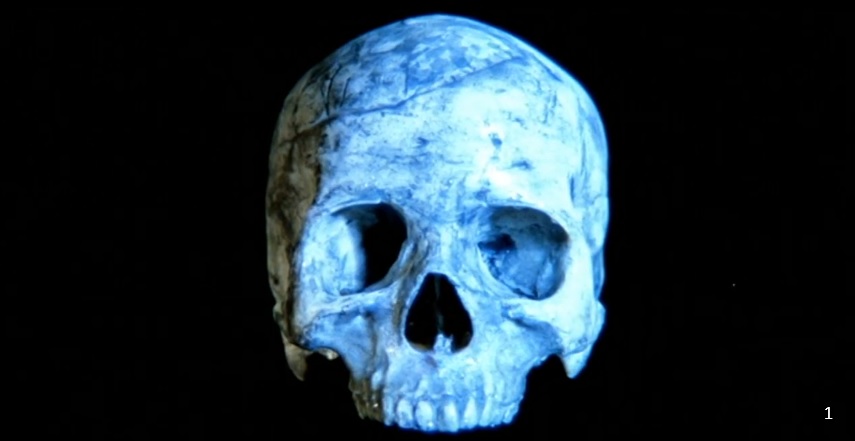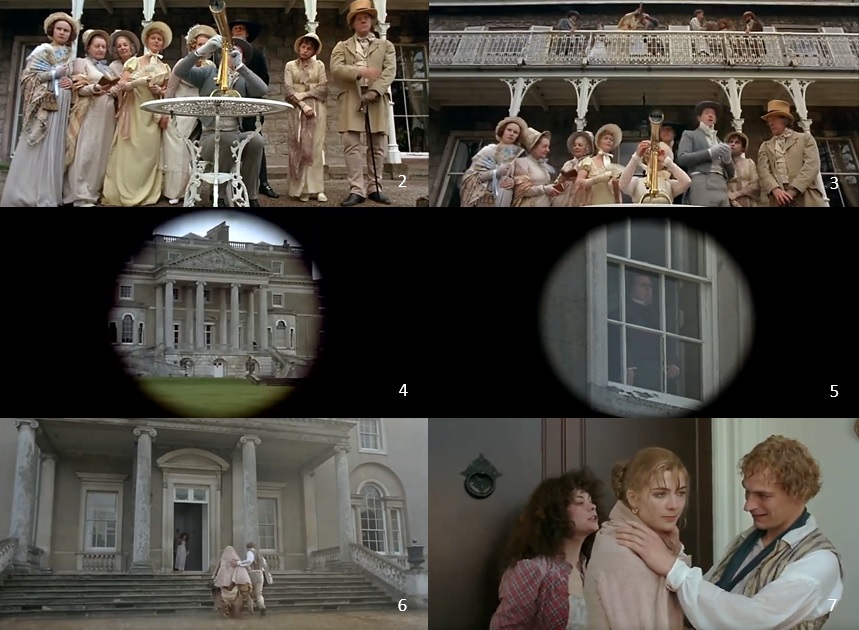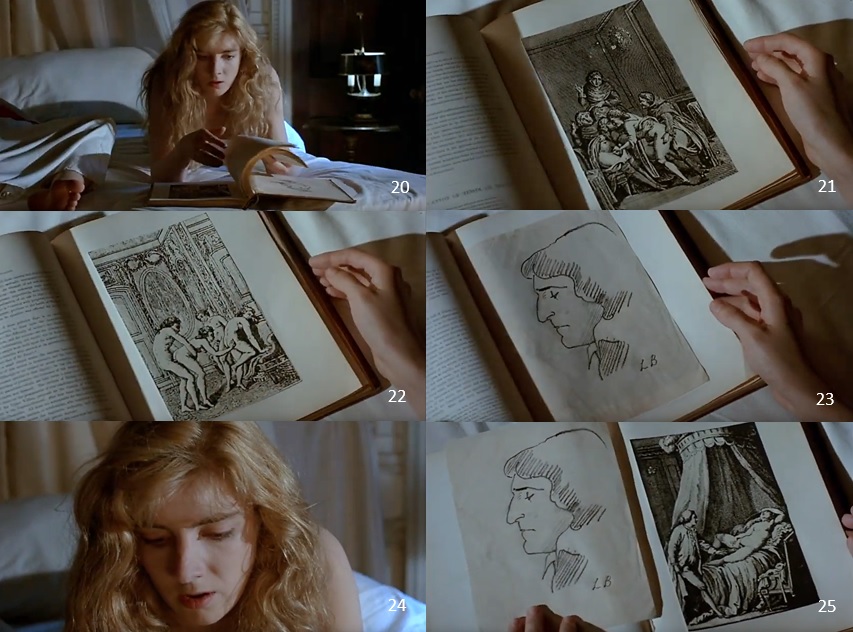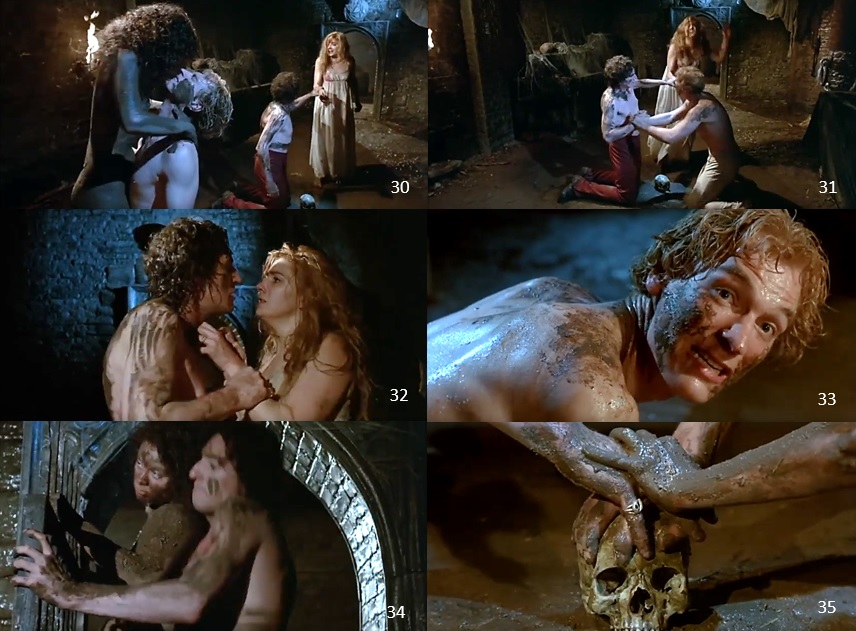![]()


■ A close-up of a skull ( 1 ) appears at the end of the opening credits of the film. The significance of this image, which is emphasized just before the story begins, is not only to indicate that the film is a suspense horror film, but also because of the story of a woman in the figure of skull that Mary Shelley, one of the characters in the film, wrote in the preface to the third edition of her book "Frankenstein" ( *B ). It may be rude to call it unexpected, but it makes us realize that Ken Russell has also read through the texts related to "Weird Tales in Villa Diodati", where the movie is set.

■ Of course, it is difficult to say that those in attendance at Real "Weird Tales" worshipped the skull as central symbol depicted in the film, but Ken Russell has succeeded in including "Mary's perspective" which is subtly distant from Byron, the host of "Weird Tales", behind the eccentricity of the story.
■ This hidden Mary Shelley perspective is connected to the behavior of sublimating her own subjectivity through the creation of Frankenstein, which sets her apart from the other participants in "Weird Tales", George Byron, Percy Shelley, John Polidori, Claire Clermont, by stepping back in the dimension of "Sexual desire". At the end of the film, Mary puts an end to the torrent of Sexual desire disguised as "the Talk about Ghost stories" by destroying the skull that has become the symbol of "Sexual coexistence", and it can be said that the hidden unconscious themes of the film converge here.
( *B )
This "story of the skeletonized woman" refers to a passage in the preface to the third edition of "Frankenstein" in which Mary describes how John William Polidori ( author of "Vampires," who was present at "Weird Tales in Villa Diodati" with Mary ) thinks that a woman looked through a keyhole and saw something that turned her into a skeleton. However, if we consider the details of the description, the story is not so much an original idea of Polidori's as if it came out of Mary's conversation with Polidori, which implies that Mary also knew "something" about the idea.
![]()

■ The area around Villa Diodati, Byron's villa, which was the focus of public gossip interest due to a sexual scandal, despite being an excellent writer, was now visited by tourists ( 2~3 ). Tourists looking at Villa Diodati through a telescope from a distance. The person standing at the right end of is Ken Russell in a cameo appearance. Mary Shelley, her husband Percy Shelley, and Claire Clermont ( 6~7 ) visiting Diodati Villa. There is an alleged love triangle between the three, although whether it is true or not is ambiguous, and it is portrayed as such in the film.

■ Byron greets the three ( 8~10 ). Byron shows his intimacy with Percy ( 11 ). However, Mary tries to dodge Byron by keeping a delicate distance ( 12 ). Byron embraces Claire in a fierce hug ( 13 ). Byron's indiscriminate sexual desire, which transcends gender differences, can be glimpsed in this scene. This is also a direction in light of Byron's ugliness at the time.

■ A Night of "Weird Tales". In this film, Ken Russell intentionally depicts everyone's curiosity about the weird as the externalization of their fascination with the sexual ( 14~19 ). Here, Ken Russell psychologically analyzes how, beneath the surface of "Weird Tales", sexual desire violated the individual attendees' mentality as Desire that transcended their individual ethics. Rather than the factual literary description of "Weird Tales" as the source of "Gothic horror", Ken Russell describes in eccentric and psychoanalytic manner the active dimensions of Drive that are too gray to be described as historical fact. It is to say that Ken Russell has made the provocative and obscene exaggeration of Subject that is too heavy to be discussed in the orthodox literary study in a way that only Ken Russell can do.

■ Mary holds an obscene literary work at the bedside of Claire, with whom Byron had sexual relationship ( 20-22 ). A portrait of Byron himself was inserted between the erotic illustrations ( 23 ). Mary is convinced of Byron's sexual desire, but is confused by its seductiveness ( 24~25 ).

■ Byron ( 26~27 ) is forced to kiss Mary, attempting to have a physical relationship with her ( 26~27 ). Byron is rejected by Mary and runs away from her( 28 ). Mary is in shock and tears ( 29 ).

■ An orgy of lasciviousness in the basement of the Villa Diodati ( 30-34 ). Here, Ken Russell presents an unconscious interpretation of the true nature of "Weird Tales", namely, that it is nothing more than "the distorted appearance of Drive ( libido )" that transcends life and death cannot be fully differentiated into the sexual Desire. The desire that cannot be contained in the literary sublimation of the weird story is dragged into the sexual dimension, and Byron and his friends try to surrender themselves to the collective pleasure that transcends their personal ethics. Here, the skull is transformed into the sexual symbol that unites everyone ( 35 ). Mary, however, is unable to join in, and refuses to join in until the end.

■ Mary, who destroys the skull and stops the frenzied collective indulgence ( 36 ) . Mary stands in the darkness surrounded by countless doors ( 37 ). It should be noted that with this development, the story, which had been told as if it was the relationship story between the five characters, is now transformed into the story as if it is Mary's delusion. This is because, as I mentioned earlier, the appearance of the skull from the beginning of the film itself is inspired by Mary's textual description. The skull itself is the symbol of Mary's shock at the collective lasciviousness at Villa Diodati, and by destroying it, she returns to the trauma of her own miscarriage ( 38~41 ).

■ Mary did in fact have a miscarriage, historically speaking, and it could be said that Ken Russell has directed this second half of the film to emphasize how traumatic that fact was for Mary. However, unlike contemporary de-sexist feminism, which depicts Mary's gender autonomy ( a position also taken by Haifaa Al-Mansour, who made "Mary Shelley ( 2017 )" ), Ken Russell's film is about Mary's transition from a woman who is seduced and played with by her sexual desires to "Human Subject" by retreating from the intoxication of sexuality throughout the truma of her life.
■ But what is still left out is that Mary's sublimely sublime escape from her subordinate position in the sexual collective was due to her creation of the literary work "Frankenstein". Such creative motivation, different from that of Byron or her husband Percy, is what enabled her to become a sole author and to leave a legacy for posterity.
